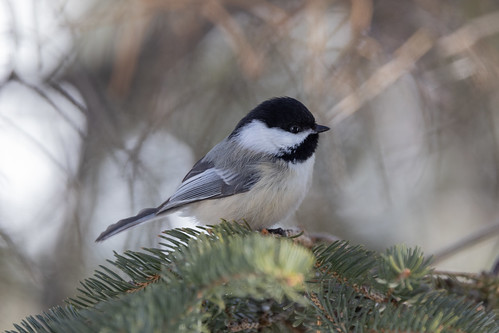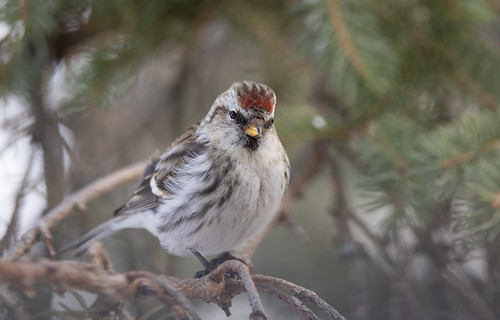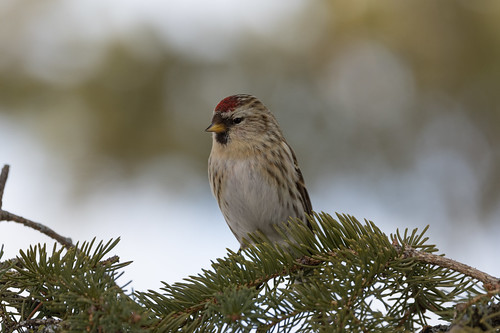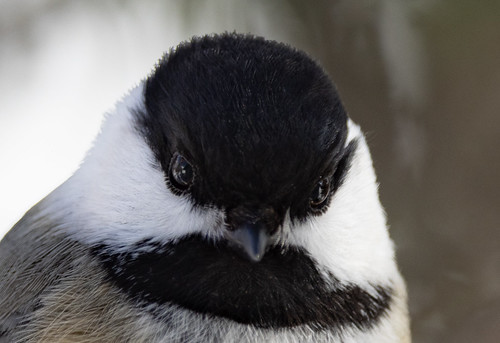All the redpolls crowding into my feeders have been filling me with both joy and the impulse to take bazillions of photos. Their plumage is so variable that no matter how many individuals I photograph, I keep seeing more beautiful variations, and want pictures of every one of them.
My home office turns out to be the perfect place for this. The redpolls come to the window feeder and, even better, spend a lot of time in the spruce tree near the window. All I have to do is lower the upper pane and click away for perfect, unobstructed shots, at least for a few seconds, and sometimes for a full minute or more. But suddenly and inevitably I hear the soft whirring of wings and insistent chattering and there goes my photo op.
One particular chickadee—I’m pretty sure the male of the pair that nested in our cherry tree last summer—has flown in. He hovers directly in front of my camera for a moment and then alights on the window, blocking my view of the redpolls. Once he even landed on my camera. I’m of course using my 500mm lens, so can’t get a picture of him except when he darts into the tree to give me a long, hard stare. At that point I can’t help but aim my camera at him, which is counterproductive as far as he’s concerned—he wants food, not a photo op—so in he zooms again. (All the chickadee photos in this blog post are of him when he's doing this. Quite a few of my chickadees make eye contact and allow me to take close up photos, but these were all taken of him during my redpoll photo sessions.)
It's not like he doesn’t have plenty of food right there—that window feeder is invariably stocked with the large peanut halves he loves topped off with dried mealworms. I’ve watched him devour those when I’m sitting at my desk with the window closed. When the feeder is full, whether my window is open or closed, all the other chickadees are just as happy to get their snacks there, but not this one guy. When he sees me at the open window, visions of wriggly, warm-alive mealworms dance in his head, and he expects me to drop everything to root through my mealworm bucket just for him.
Of course I oblige him. If I’m entirely focused on taking redpoll pictures, giving him mealworms is the only way he’ll fly off long enough for me to take a few more before he returns. But there’s something else at play, too. When this little guy, so adorable, so confiding, looks right into my eyes, he can wrap me around his tiny claw the exact way my adorable, confiding, one-and-a-half-year-old grandson Walter wraps me around his little finger. I’m Walter’s primary childcare provider during the work week. He’s pretty good at entertaining himself right up until the moment I answer an email or take a phone call. That’s when he looks up at me with those adorable dark eyes filled with expectation, wraps his tiny hand around my little finger, and tugs. Of course I oblige him, though he doesn’t want mealworms—he wants Grandma’s full attention.
We humans see chickadees through the eyes of a species that produces helpless young that remain dependent for years, so what our eyes recognize as cute or adorable often elicits both smiles and an impulse to nurture. Compared to adults, human babies are tiny with relatively large eyes, plump bodies, and oversized heads—features that help define cuteness to our eyes. Small wonder chickadees are so universally considered cute and endearing. Of course, a chickadee's oversized head didn’t evolve to appeal to us—their head size is evidence of learning capacity. Chickadees readily figure out how to manipulate things in their environment including, in this case, a little old lady in her home office, to get what they want. Even at their most annoying, their adorableness wins out, and so I can’t help but smile and indulge the winsome little creature at hand, whether it's Walter or one particular chickadee.
I don’t usually give my chickadees names, but this guy who knows just what buttons to push to bend me to his will turns out to have an obvious one. I’m calling him Little Walter.







